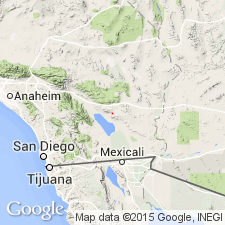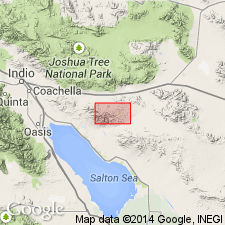
- Usage in publication:
-
- Diligencia Formation
- Modifications:
-
- Named
- Dominant lithology:
-
- Conglomerate
- Sandstone
- Mudstone
- AAPG geologic province:
-
- Salton basin
Summary:
Named for Spanish word for stagecoach. Type section designated as beds along north-south cross section from contact with augen gneiss beginning at point 850 m S 75 deg E from Canyon Spring, sec.29 T7S R13E, Hayfield 15' quad, Riverside Co, CA. Consists of red, maroon, yellow, nonmarine conglomerate, sandstone, and mudstone with interbedded volcanic flows and sills. Thickness is 1500 m. Unconformably overlies Maniobra Formation on north, augen gneiss and migmatite on south. Unconformably underlies unnamed fan, terrace, and alluvial deposits of Quaternary age. Age given as Oligocene(?) to early Miocene.
Source: GNU records (USGS DDS-6; Menlo GNULEX).

- Usage in publication:
-
- Diligencia Formation
- Modifications:
-
- Age modified
- Geochronologic dating
- AAPG geologic province:
-
- Salton basin
Summary:
Divided into 5 informal units: unit 1, volcanic unit [this one not numbered], unit 2, unit 3, unit 4. Units shown on geologic sketch map of eastern part of Orocopia Mountains, southern CA. Detailed discussion of stratigraphy, lithology, petrology, sedimentology, and structure included in report. Most of formation is early Miocene (Arikareean) in age based on radiometric (23.0 +/-2.9, 20.6 +/-8.9, and 19.1 +/-1.9 Ma) and paleontologic evidence. Coarse clastic sediments beneath dated rocks were rapidly deposited and are probably early Miocene in age but base may extend into Oligocene. No upper limit in age can be assigned to formation due to lack of diagnostic fossils or fresh volcanic rocks in upper part and because erosion has removed some of youngest rocks.
Source: GNU records (USGS DDS-6; Menlo GNULEX).
For more information, please contact Nancy Stamm, Geologic Names Committee Secretary.
Asterisk (*) indicates published by U.S. Geological Survey authors.
"No current usage" (†) implies that a name has been abandoned or has fallen into disuse. Former usage and, if known, replacement name given in parentheses ( ).
Slash (/) indicates name conflicts with nomenclatural guidelines (CSN, 1933; ACSN, 1961, 1970; NACSN, 1983, 2005, 2021). May be explained within brackets ([ ]).

